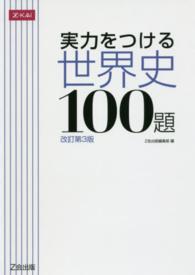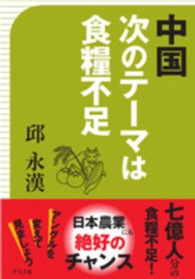Full Description
Developed by practicing artists, Art for Everyone is a practical and accessible guide to art appreciation that emphasizes the creative process and the importance of art in our everyday lives. Art for Everyone pairs a thorough exploration of art techniques with the most concise introduction to art history available, highlighting topics that are meaningful to today's students.
Contents
Preface
About the Authors
Acknowledgements
List of Reviewers
PART ONE: THE LANGUAGE OF ART
1. What Is Art?
Leading Questions
Active Looking
Learning to See
Responding to Art
Objective Responses
Subjective Responses
Close Examination: Objective and Subjective Descriptions of van Gogh's The Starry Night
The Language of Art
Medium, Form, and Content
The Formal Elements
Artist at Work: Wohaw's A Man Receiving Power from Two Spirit Animals
Beauty and Aesthetics
Definitions of Beauty
Art in Process: Constructing: One Sculptor's Technique
Conclusion
Review and Do
Key Terms
2. Formal Elements
The Building Blocks of Art
Line
Expressive Lines
Close Examination: Line in Mary Cassatt's In the Loge
Shape
Expressive Shapes
Artist at Work: Maria Peñil Cobo's Bacteria Paintings
Positive and Negative Shape
Value
Value Range
Simultaneous Contrast
Chiaroscuro
Color
Color Attributes
Twelve-Part Color Wheel
Color Temperature
Color Schemes
Objective and Expressive Color
Art in Process: Color Mixing
Texture
Tactile Texture
Visual Texture
Space
Constructing Three-Dimensional Space
Constructing Space on a Two-Dimensional Plane
Illusion of Mass
Overlapping
Atmospheric Perspective
Linear Perspective
Isometric Perspective
Conclusion
Review and Do
Key Terms
3. Principles of Design
Order from Chaos
Unity
Harmony and Variety
Repetition
Continuation
Focal Point
Emphasis by Contrast
Emphasis by Isolation
Emphasis by Placement
Absence of a Focal Point
Close Examination: The Bauhaus and Principles of Design
Balance
Symmetrical Balance
Radial Balance
Asymmetrical Balance
Proportion and Scale
Rhythm
Artist at Work: Marie Watt's Transportation Object (Lamp)
Conclusion
Review and Do
Key Terms
4. Style and Technique
Evolution of Style and Technique
Differences in Style and Technique
Recognizing Style
Representational Art
Artist at Work: Style and Rosa Bonheur
Abstract Art
Close Examination: Nonobjective Abstraction in Hilma af Klint's Art
Nonrepresentational Art
Recognizing Technique
Painterly Technique
Plastic Technique
Linear Technique
Conclusion
Review and Do
Key Terms
PART TWO: THE MAKING OF ART
5. Drawing and Painting
What's an Artist to Do?
Drawing
Drawing Media
Ink
Charcoal
Chalk
Pastels
Graphite
Conté
Mixed Media and Collage
Art in Process: Drawing
Painting
Close Examination: Three Faces, Three Approaches, Three Results
Painting Media
Encaustic
Egg Tempera
Fresco
Oil
Watercolor
Acrylic
Art in Process: Oil Painting
Conclusion
Review and Do
Key Terms
6. Printmaking, Photography, and Digital Art
Making Multiples
Printmaking
Relief Printing
Intaglio Printing
Close Examination: Käthe Kollwitz's Etchings
Planar Printing
Photography
Development of Photography
Photography Processes
Art in Process: Developing Film and Printing Photographs
Photography as Documentation and Art
Collage
Artist at Work: Narrative in Danielle Delph's If I Had Known My Mother Back Then
Digital Art
Animation
Virtual Reality
Conclusion
Review and Do
Key Terms
7. The Craft Tradition
The World of Craft
Crafts
Fine and Applied Art
Form and Function
Fiber Arts
Weaving
Textiles
Close Examination: Traditional Motifs in Contemporary Weaving
Embroidery
Quilting and Felting
Woodworking
Materials and Methods
Glassmaking
Materials and Methods
Metalwork
Materials and Methods
Artist at Work: Ana M. Lopez's Wearable Art
Ceramics
Materials and Methods
Decoration and Finished Product
Close Examination: The Importance of Heat
Art in Process: Working with Clay
Conclusion
Review and Do
Key Terms
8. Sculpture, Installation Art, Architecture, and Public Art
Art That Reflects Us
Sculpture
Historical and Cultural Significance
Freestanding Sculpture
Sculpture in Relief
Methods and Materials
Subtractive Method
Additive Method
Manipulation
Substitutive Method
Art in Process: Lost Wax Casting
Installation Art
Architecture
Prehistoric Homes
Ancient Construction
Gothic Technologies
International Style
Building as Art
Public Art
Memorials
Close Examination: Maya Lin's Vietnam Veterans Memorial
Monuments
Murals
Artist at Work: Hector Hernandez's Murals
Conclusion
Review and Do
Key Terms
9. Time-Based Art
Human Actions as Art
Elements of Time-Based Art
Duration
Intensity and Tension
Pacing and Rhythm
Transitions
Artist at Work: Angela Ellsworth's Drawing on Site
Materials of Time-Based Art
Action
Props
Sound
Audience and Setting
Close Examination: Time-Based Elements in Ellen Mueller's What It Takes
Performance Art
Participatory Performances
Durational Performances
Site-Specific Performance
Art in Process: Ana Mendieta's Earth Body Works
Video Art and Animation
Social Practice Art
Institutional Critique
Augmented and Virtual Reality
Conclusion
Review and Do
Key Terms
PART THREE: THE STORY OF ART
10. Art History, Part 1
Where Does Art Start?
Prehistoric Art
Stories in Stone
Clay and Civilization
Tools for Spirituality
Ancient Art
For Power and Privilege
For Transformation
For the Pursuit of Perfection and Beauty
For the End of an Era
For the People
Medieval Art
Iconic Images
Close Examination: Mayan Civilization in a Cup
Warrior in Art and Culture
The Giver of Life
Art as Religious Literature
Artists at Work: Stone Masons and the Workshop Tradition
The Renaissance
Art for Teaching and Innovation
Art of Conflict
Baroque and Rococo Art
Frivolity versus Loyalty
Neoclassical and Romantic Art
Romanticism and Nature
Art in Process: Etching and Printmaking
Conclusion
Review and Do
Key Terms
11. Art History, Part 2
From Nineteenth-Century Art to Now
Changes in Art
Make Way for the Avant-Garde
Realism and the Painting of Modern Life
Impressionism
Studies of Life and Light
Artist at Work: Claude Monet's Rouen Cathedrals
First Impressionist Exhibition
Postimpressionism
Radical Independence
Fauvism
Cubism
Simultaneous Perspectives
Dynamic Movement
Close Examination: Extreme Abstraction in Kazimir Malevich's White on White
Futurism
Geometric Abstraction
De Stijl
Minimalism
Pure Expression
Abstract Expressionism
Color Field Painting
Art in Process: Barnett Newman's Voice of Fire
Conceptual Art
Dada
Surrealism
Abject Art
Appropriation
Pop Art and Postmodernism
Pop Art
Postmodernism
Conclusion
Review and Do
Key Terms
12. Art Is Everywhere
Where Is Art?
Art on Display
Museums
College and University Galleries
Art Galleries, Fairs, and Festivals
Art Districts
Informal Exhibitions
Graffiti
Artist at Work: Diane Jacobs on Artist Books and Residencies
Art and Visual Culture
Advertisements
Propaganda
Close Examination: Active Looking and Cultural Capital
Art in Us
The Art Instinct
The Creative Process
Art as Healing
Art as Connection
Art as Play
Art Classes
Conclusion
Review and Do
Key Terms
Glossary
References
Index








